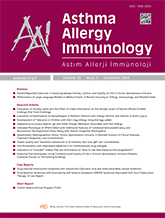


Objective: There is currently a lack of comprehensive studies that provide clear information about the frequency and characteristics of hypersensitivity reactions associated with H1 antihistamines. The aim of our study was to evaluate the subjects with antihistamine drug allergy diagnosed in our clinic and the provocation tests performed on them with alternative agents.
Materials and Methods: This retrospective study was carried out at the immunology and allergy clinic in a tertiary hospital. The study population consisted of adults who presented to our allergy clinic between January 1, 2017 and December 31, 2023 with a history of H1 antihistamine drug allergy and underwent alternative H1 antihistamine drug provocation tests, for whom records were accessible.
Results: A total of 45 patients were included in the study. The mean age of the patients was 39.75 ± 13.30 years with 34 (75.55%) being female. Regarding the initial allergic reaction history to H1 antihistamine drugs, allergic reactions occurred with pheniramine hydrogen maleate in 17 (37.77%), with levocetirizine dihydrochloride in 9 (20%), with desloratadine in 7 (15.55%), with cetirizine dihydrochloride in 6 (13.33%), with bilastine in 6 (13.33%), with rupatadine fumarate in 3 (6.66%) patients, and with fexofenadine hydrochloride 1 patient (2.22%). Allergic reactions developed in 7 (15.55%) patients during oral provocation tests.
Conclusion: In conclusion, caution is advised with H1 antihistamine hypersensitivity. Misinterpreting hypersensitivity symptoms as those of the primary allergic condition may lead to treatment delays or unnecessary escalation, potentially resulting in life-threatening reactions. Additionally, further research is needed to clarify which antihistamines pose higher allergic risks and to guide the selection of alternatives for testing.